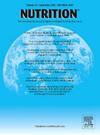Development and validation of a predictive equation for resting energy expenditure in Japanese patients with interstitial lung disease
IF 3.2
3区 医学
Q2 NUTRITION & DIETETICS
引用次数: 0
Abstract
Background and Aims
This study developed a prediction equation for resting energy expenditure (REE) in patients with interstitial lung disease (ILD) using indirect calorimetry and examined the errors in the prediction equation.
Methods
This study consisted of two key phases: Study 1 focused on developing the prediction equation for REE, whereas Study 2 evaluated the accuracy of this equation through validation and error analysis. In Study 1, REE was measured, and a regression model equation was created to predict REE using multiple regression analysis, with measured REE (mREE) as the dependent variable. In Study 2, a Bland-Altman analysis was conducted to examine the phylogenetic error and agreement between predicted REE (pREE) calculated from the prediction equations developed in Study 1 and mREE.
Results
In Study 1, mREE was significantly associated with fat-free mass (FFM), and the prediction equation for REE was 456.988 + 22.539 × FFM. The addition error (0.4 ± 166.1, 95% confidence interval (CI): −55.8 to 56.6, P = 0.988) and proportional error (r = 0.223, P = 0.191) between mREE and pREE were not significantly different, with an agreement of 69.4%.
Conclusions
The mREE prediction equation developed in this study showed no systematic errors and exhibited higher agreement compared with existing prediction equations. The prediction equation for REE specific to patients with ILD obtained in this study has the potential for clinical application.

日本间质性肺病患者静息能量消耗预测方程的开发与验证
背景与目的本研究建立了间质性肺疾病(ILD)患者静息能量消耗(REE)的间接量热法预测方程,并检验了预测方程的误差。方法本研究分为两个关键阶段:研究1重点建立稀土元素预测方程,研究2通过验证和误差分析对方程的准确性进行评价。在研究1中,测量了稀土元素,并以测量的稀土元素(mREE)为因变量,通过多元回归分析建立了预测稀土元素的回归模型方程。在研究2中,进行了Bland-Altman分析,以检验从研究1中建立的预测方程计算的预测REE (pREE)与mREE之间的系统发育误差和一致性。结果在研究1中,稀土元素与无脂质量(fat-free mass, FFM)显著相关,其预测方程为456.988 + 22.539 × FFM。mREE和pREE的附加误差(0.4±166.1,95%可信区间(CI):−55.8 ~ 56.6,P = 0.988)和比例误差(r = 0.223, P = 0.191)差异无统计学意义,一致性为69.4%。结论本文建立的稀土元素预测方程不存在系统误差,与现有预测方程具有较高的一致性。本研究获得的ILD患者特异性REE预测方程具有临床应用潜力。
本文章由计算机程序翻译,如有差异,请以英文原文为准。
求助全文
约1分钟内获得全文
求助全文
来源期刊

Nutrition
医学-营养学
CiteScore
7.80
自引率
2.30%
发文量
300
审稿时长
60 days
期刊介绍:
Nutrition has an open access mirror journal Nutrition: X, sharing the same aims and scope, editorial team, submission system and rigorous peer review.
Founded by Michael M. Meguid in the early 1980''s, Nutrition presents advances in nutrition research and science, informs its readers on new and advancing technologies and data in clinical nutrition practice, encourages the application of outcomes research and meta-analyses to problems in patient-related nutrition; and seeks to help clarify and set the research, policy and practice agenda for nutrition science to enhance human well-being in the years ahead.
 求助内容:
求助内容: 应助结果提醒方式:
应助结果提醒方式:


